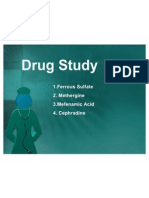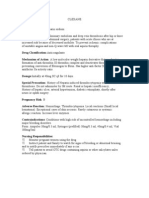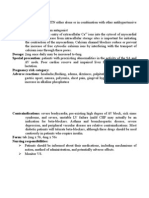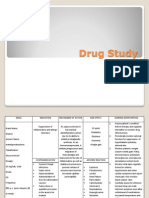Drug Study
Drug Study
Uploaded by
zbestgurlCopyright:
Available Formats
Drug Study
Drug Study
Uploaded by
zbestgurlOriginal Description:
Copyright
Available Formats
Share this document
Did you find this document useful?
Is this content inappropriate?
Copyright:
Available Formats
Drug Study
Drug Study
Uploaded by
zbestgurlCopyright:
Available Formats
DRUG STUDIES
DRUG NAME
DATE ORDERED
CLASSIFICATION
DOSE ROUTE FREQUENCY
2 G IVTT Q12H ANST ( - ) PLS GIVE THRU IV DRIP
MECHANISM OF ACTION
SPECIFIC INDICATIO N
UTI
SIDE EFFECTS
NURSING IMPLICATIONS
CEFTRIAXONE SODIUM (ROCEPHIN)
8-7-2013
ANTIBIOTIC
Inhibits cell wall synthesis, promoting osmotic instability; usually bactericidal
COMMON S/E Diarrhea Rashes Pain @ injection site
ADVERSE S/E Pseudomembranous Colitis Leukopenia Anaphylaxis
BEFORE 1.Ask patient if hes allergic to penicillins or cephalosporins 2.Obtain specimen for culture and sensitivity tests before giving first dose 3.Monitor CBC, renal and liver function tests DRUG PREPARATION 1.Dilute 2 G vial with 19.2 mL of sterile water, NSS, or D5W 2.Do not mix or coadminister Ceftriaxone with calcium-containing IV solutions DURING 1.Give over 30 minutes
DRUG NAME
DATE ORDERED
CLASSIFICATION
DOSE ROUTE FREQUENCY
MECHANISM OF ACTION
SPECIFIC INDICATION
SIDE EFFECTS
NURSING IMPLICATIONS
AFTER 1. Tell patient to report discomfort at IV insertion site 2. Tell patient to report loose stools or diarrhea
DRUG NAME
DATE ORDERED
CLASSIFICATION
DOSE ROUTE FREQUENC Y
400 MG TAB 1 TAB BID PO
MECHANISM OF ACTION
SPECIFIC INDICATION
SIDE EFFECTS
NURSING IMPLICATIONS
OFLOXACIN (FLOXIN)
8-7-2013
FLUOROQUINOLON E
Interferes with DNA gyrase, which is needed for synthesis of bacterial DNA. Spectrum of action includes many gram-positive and gram-negative aerobic bacteria
COMPLICATED UTI
COMMON S/E Drowsiness Dizziness Nausea Vomiting Abdominal pain
BEFORE 1. Obtain specimen for sensitivity and culture test 2. Monitor CBC, renal and liver function tests DURING 1. Drug maybe taken with or without regard to meals 2. Take each dose with a full glass of water 3. Take the drug 1 hour before or 2 hours after antacids AFTER 1. Avoid sun exposure 2. Take antacids 1 hour before or 2 after after Ofloxacin 3. Warn patient that dizziness may occur 4. Tell patient to stop drug and report @ first sign of allergic reaction
ADVERSE S/E Pseudomembranous Colitis Anaphylactic reaction Leukopenia
DRUG NAME
DATE ORDERED
CLASSIFICATION
DOSE ROUTE FREQUENCY
500 MG / 400 MG 1 TAB OD PO
MECHANISM OF ACTION
SPECIFIC INDICATION
SIDE EFFECTS
NURSING IMPLICATIONS
DUTASTERIDE + TAMSULOSIN (DUODART)
8-87-2013
ALPHA ADRENORECEPTOR ANTAGONIST
Blocks alpha adrenergic receptors in the prostate. This action inhibits smooth muscle contraction in the prostate, prostatic capsule, prostatic urethra, and bladder neck, which improves the rate of urine flow & reduce symptoms of BPH
TO TREAT BPH
COMMON S/E Dizziness Drowsiness Orthostatic Hypotension Diarrhea
BEFORE 1.Rule out prostate cancer DURING 1.Take drug 30 min after same meal each day 2.Do not open, crush, or chew drug capsules AFTER 1.Change position slowly to minimize effect of orthostatic hypotension 2.Avoid hazardous activities until CNS effects are known
DRUG NAME
DATE ORDERED
CLASSIFICATION
DOSE ROUTE FREQUENCY
30 CC QHS PO HOLD FOR BM GREATER THAN 2X / DAY
MECHANISM OF ACTION
SPECIFIC INDICATION
SIDE EFFECTS
NURSING IMPLICATIONS
LACTULOSE (CEPHULAC)
8-8-2013
LAXATIVE
Produces an osmotic effect in colon; resulting distention promotes peristalsis. Also decreases ammonia, probably as a result of bacterial degradation, which lowers the pH of colon contents.
CONSTIPATION
COMMON S/E Abdominal cramps Belching Diarrhea Flatulence Gaseous distention Nausea Vomiting
BEFORE 1. Assess pattern of bowel movement 2. Monitor serum electrolytes especially sodium and potassium DURING 1. Advise patient to increase water intake at least 2-3 L / day to prevent dehydration 2. Avoid using antacids and lactulose together 3. Tell patient not to use other laxatives during lactulose therapy AFTER 1. Assess effectiveness of medicine 2. Document findings and interventions done
DRUG NAME
DATE ORDERED
CLASSIFICATION
DOSE ROUTE FREQUENCY
500 MG TAB 1 TAB Q4H PRN FOR T > 38 C
MECHANISM OF ACTION
SPECIFIC INDICATION
SIDE EFFECTS
NURSING IMPLICATIONS
ACETAMINOPHEN (PARACETAMOL)
8-7-2013
ANALGESIC
Thought to produce analgesia by inhibiting prostaglandin & other substances that sensitize pain receptors. Drug may relieve fever through central action in the hypothalamic heat-regulating center
FOR FEVER
COMMON S/E Drowsiness Nausea Vomiting Abdominal pain
BEFORE 1. Monitor body temperature 2. Monitor CBC and U/A 3. Monitor LFT DURING 1. Take only as directed and with food or milk to decrease GI upset 2. Limit caffeine intake 3. Avoid alcohol as this may cause hepatotoxicity AFTER 1. Recheck body temperature after 30 min of administration 2. Report any adverse reactions 3. Document findings and interventions done
ADVERSE S/E Leukopenia Neutropenia Hypoglycemia Hemolytic anemia
FOOD-DRUG INTERACTIONS CAFFEINE (Increase analgesic effect) ALCOHOL (Increase risk of liver damage)
DRUG NAME
DATE ORDERED
CLASSIFICATION
DOSE ROUTE FREQUENCY
2 TABS TID X 3 DAYS AND 1 TAB FOR NEXT SUCCEEDING DAYS P.O.
MECHANISM OF ACTION
SPECIFIC INDICATION
SIDE EFFECTS
NURSING IMPLICATIONS
DIOSMIN + HESPERIDIN (DAFLON)
8-10-2013
MULTIVITAMIN
Daflon is phlebotonic. It reinforces venous tone by prolonging the activity of parietal noradrenaline. Thus, Daflon decreases venous capacitance, venous distensibility, & venous emptying time
ACUTE HEMORRHOIDAL ATTACKS AND CHRONIC HEMORRHOIDAL DISEASE
Upset stomach Headache Nausea Vomiting Unusual taste in mouth
BEFORE 1. Note indication for therapy DURING 1. Take with food AFTER 1. Report any adverse reactions 2. Document findings and interventions done
You might also like
- Head Toe Physical AssessmentDocument2 pagesHead Toe Physical Assessmentzbestgurl100% (2)
- The Infamous Loserlimab RTF LetterDocument21 pagesThe Infamous Loserlimab RTF Letterbuyersstrikewp100% (3)
- ACB Scale - Legal Size PDFDocument2 pagesACB Scale - Legal Size PDFMarina Swanson0% (1)
- Drugs in SportDocument180 pagesDrugs in Sportaermal89100% (1)
- Chapter 21 Antidepressant AgentsDocument4 pagesChapter 21 Antidepressant AgentsNicolle Lisay IlaganNo ratings yet
- Drug Study Ko ToDocument4 pagesDrug Study Ko ToGian Carlo FernandezNo ratings yet
- BisacodylDocument1 pageBisacodylianecunarNo ratings yet
- OB Drug StudyDocument12 pagesOB Drug StudyCj AttoNo ratings yet
- P 398Document1 pageP 398Arup Ratan PaulNo ratings yet
- EsomeprazoleDocument1 pageEsomeprazoleamaliea234No ratings yet
- Drug AnalysisDocument3 pagesDrug AnalysisAnn Aquino100% (1)
- Vasotec EnalaprilDocument1 pageVasotec EnalaprilCassie100% (1)
- New DS3Document3 pagesNew DS3dakieNo ratings yet
- Drug Study of Mannitol RMCDocument1 pageDrug Study of Mannitol RMCAdrian Ardamil0% (1)
- AlgesiaDocument1 pageAlgesiaSaf DicamNo ratings yet
- Salazar DsDocument4 pagesSalazar DsDjayNo ratings yet
- DRUG STUDY Allopurinol (Purinase)Document2 pagesDRUG STUDY Allopurinol (Purinase)DennMarkTaponNo ratings yet
- Calcitriol - Drug InformationDocument13 pagesCalcitriol - Drug InformationNikesh DoshiNo ratings yet
- Pregnancy Risk Category B DIN RD TrimesterDocument7 pagesPregnancy Risk Category B DIN RD TrimesterLheajane SocratesNo ratings yet
- Sodium BicarbonateDocument1 pageSodium BicarbonateALbinong VelascoNo ratings yet
- Furosemid Citicoline Clexane, LevofloxacinDocument9 pagesFurosemid Citicoline Clexane, Levofloxacincotyboy50% (2)
- FdarDocument1 pageFdarRoxas Cedrick100% (1)
- Side Effects:: AtropineDocument7 pagesSide Effects:: AtropinekletadaNo ratings yet
- Generic Name: Brand Name: Pletal: Pharmacologic Class: Pharmacokinetics General Indications Contraindications BeforeDocument2 pagesGeneric Name: Brand Name: Pletal: Pharmacologic Class: Pharmacokinetics General Indications Contraindications Beforeart_mutantNo ratings yet
- IbuprofenDocument3 pagesIbuprofenapi-3797941100% (1)
- DRUG LactuloseDocument1 pageDRUG LactuloseJona Phie Domingo MonteroNo ratings yet
- As Pi LetDocument7 pagesAs Pi Letianecunar100% (1)
- Drug StudyDocument7 pagesDrug StudyMae Navidas DigdiganNo ratings yet
- Omeprazole - Drug StudyDocument2 pagesOmeprazole - Drug StudyJun Gilbuena100% (1)
- MultivitaminDocument1 pageMultivitaminAdrianne BazoNo ratings yet
- Humulin R, Novolin RDocument2 pagesHumulin R, Novolin RSheri490100% (2)
- Drug StudyDocument10 pagesDrug Studyjho_26100% (2)
- Nifedipine and Prednisone Drug StudyDocument5 pagesNifedipine and Prednisone Drug StudyAllyne GavinoNo ratings yet
- Drug StudyDocument3 pagesDrug StudyKristine Faith AzcuetaNo ratings yet
- NafarinDocument2 pagesNafarinianecunar100% (2)
- Micromonospora Purpurea. Action IsDocument3 pagesMicromonospora Purpurea. Action IsCarlos H. AcuñaNo ratings yet
- Essential Amino AcidDocument1 pageEssential Amino AcidKayki LouiseNo ratings yet
- Itopride HCL Pynetic 50mg TabDocument2 pagesItopride HCL Pynetic 50mg TabAusaf AhmadNo ratings yet
- Activated CharcoalDocument1 pageActivated CharcoalSupreeth PrasadNo ratings yet
- Drug Study 2Document8 pagesDrug Study 2rey_tengNo ratings yet
- Drug Study Cap RHPDocument7 pagesDrug Study Cap RHPJan DeeNo ratings yet
- Methyldopa, Losartan K, Ascorbic AcidDocument4 pagesMethyldopa, Losartan K, Ascorbic AcidRico Mae ValenciaNo ratings yet
- KaliumDocument2 pagesKaliumJustine Kaye Iballa HarligaNo ratings yet
- Discharge Instructions For Lap CholeyDocument1 pageDischarge Instructions For Lap CholeyAnne Marie Angelica BilonoNo ratings yet
- OxaliplatinDocument10 pagesOxaliplatinlum_albertNo ratings yet
- DRUG STUDY MetroclopramideDocument2 pagesDRUG STUDY MetroclopramideMimay Gabo Gonzales100% (6)
- TRAMADOLDocument4 pagesTRAMADOLRudie Lee PascualNo ratings yet
- Drug Study - CholangioDocument10 pagesDrug Study - CholangioClaireMutiaNo ratings yet
- Tramadol, Paracetamol, Calmoseptine, B12Document5 pagesTramadol, Paracetamol, Calmoseptine, B12Denise EspinosaNo ratings yet
- LacipilDocument2 pagesLacipilianecunarNo ratings yet
- Therabloc DrugDocument2 pagesTherabloc DrugMsOrangeNo ratings yet
- Drug StudyDocument7 pagesDrug StudyKynaWeeNo ratings yet
- Assesment Diagnosis Planning Interventio N Rationale EvaluationDocument2 pagesAssesment Diagnosis Planning Interventio N Rationale EvaluationRenea Joy ArruejoNo ratings yet
- Drug StudyDocument17 pagesDrug StudyTherese ArellanoNo ratings yet
- NCP Gastric CancerDocument6 pagesNCP Gastric Cancerhayascent hilarioNo ratings yet
- The Ride of Your Life: What I Learned about God, Love, and Adventure by Teaching My Son to Ride a BikeFrom EverandThe Ride of Your Life: What I Learned about God, Love, and Adventure by Teaching My Son to Ride a BikeRating: 4.5 out of 5 stars4.5/5 (2)
- Ventricular Septal Defect, A Simple Guide To The Condition, Treatment And Related ConditionsFrom EverandVentricular Septal Defect, A Simple Guide To The Condition, Treatment And Related ConditionsNo ratings yet
- Drug Study2Document8 pagesDrug Study2zbestgurlNo ratings yet
- Complete Drugs StudyDocument13 pagesComplete Drugs StudyPeace Andong PerochoNo ratings yet
- CefuroximeDocument6 pagesCefuroximetrinkets0914No ratings yet
- Neuropathic Pain Diabetic Peripheral NeuropathyDocument7 pagesNeuropathic Pain Diabetic Peripheral NeuropathyJomabee TuArNo ratings yet
- To Control Nausea and Vomiting: Drug StudyDocument2 pagesTo Control Nausea and Vomiting: Drug StudyPeace Andong PerochoNo ratings yet
- Drug StudyDocument3 pagesDrug StudyJaylean Abrigo AguinaldoNo ratings yet
- 8copd DrugtabncpDocument18 pages8copd DrugtabncpMaristelaMolinaNo ratings yet
- Therapeutic:: Nausea Constipation Dizziness Headache Vomiting Dry Mouth Diarrhea Rash VertigoDocument9 pagesTherapeutic:: Nausea Constipation Dizziness Headache Vomiting Dry Mouth Diarrhea Rash VertigoKaren GonzalesNo ratings yet
- Postop Drug2Document3 pagesPostop Drug2zbestgurlNo ratings yet
- Postop Drug1Document3 pagesPostop Drug1zbestgurlNo ratings yet
- Ra 9165Document26 pagesRa 9165zbestgurl100% (1)
- Anatomy & Physiology of The Human Rectum and AnusDocument1 pageAnatomy & Physiology of The Human Rectum and Anuszbestgurl0% (1)
- Discharge PlanningDocument1 pageDischarge PlanningzbestgurlNo ratings yet
- CaseDocument19 pagesCaseAlmira Ballesteros CestonaNo ratings yet
- Drug Study2Document8 pagesDrug Study2zbestgurlNo ratings yet
- Risk For Impaired Skin IntegrityDocument2 pagesRisk For Impaired Skin Integrityzbestgurl100% (1)
- Assessment Using Functional Health Patterns: AppendixDocument16 pagesAssessment Using Functional Health Patterns: AppendixNalzaro Emyril89% (19)
- Heart Failure Review QuestionsDocument33 pagesHeart Failure Review Questionszbestgurl100% (2)
- Charlott DaceraDocument3 pagesCharlott DacerazbestgurlNo ratings yet
- Charlott DaceraDocument3 pagesCharlott DacerazbestgurlNo ratings yet
- Fundamentals of NursingDocument48 pagesFundamentals of Nursinganon-429003100% (31)
- ImpetigoDocument66 pagesImpetigozbestgurlNo ratings yet
- Pediculosis Capi.sDocument17 pagesPediculosis Capi.szbestgurlNo ratings yet
- Chapter 27Document22 pagesChapter 27zbestgurlNo ratings yet
- MSDS Timolol MaleateDocument5 pagesMSDS Timolol MaleatezbestgurlNo ratings yet
- Chapter 27Document22 pagesChapter 27zbestgurlNo ratings yet
- Ncm102 - Laboratory: 14 Rights of Drug AdministrationDocument1 pageNcm102 - Laboratory: 14 Rights of Drug AdministrationzbestgurlNo ratings yet
- Classification: Cerebral PalsyDocument3 pagesClassification: Cerebral PalsyzbestgurlNo ratings yet
- ImpetigoDocument66 pagesImpetigozbestgurlNo ratings yet
- Unit 3-OutpatientDocument38 pagesUnit 3-OutpatientSharmila LamisharNo ratings yet
- Clinician Ep Onset eDocument2 pagesClinician Ep Onset eInga CebotariNo ratings yet
- CetirizineDocument1 pageCetirizineGabby Robles Paje100% (1)
- Medication FoundationDocument21 pagesMedication FoundationAlexandra MihaelaNo ratings yet
- Stok ANTIBIOTIKregDocument20 pagesStok ANTIBIOTIKregANTONIUS BAYUNo ratings yet
- InnojectorDocument46 pagesInnojectorKhông Biết DùngNo ratings yet
- 9) AntiretroviralDocument79 pages9) AntiretroviralOkot ChristopherNo ratings yet
- Basics of VentilationDocument69 pagesBasics of Ventilationdr_nkhan3415No ratings yet
- Radiation TherapyDocument22 pagesRadiation Therapymweid7283No ratings yet
- Asthma Training Module - 2013Document204 pagesAsthma Training Module - 2013Dr_Bhavesh_ParmarNo ratings yet
- Orange Book 2010Document1,114 pagesOrange Book 2010Sadia Yasmeen100% (1)
- TramadolDocument3 pagesTramadolMark Joseph Mabazza LappayNo ratings yet
- Long Quiz Antimicrobials Antifungals Antituberculosis AnticancerDocument5 pagesLong Quiz Antimicrobials Antifungals Antituberculosis AnticancerJen PanganibanNo ratings yet
- PHM 3471 Merged Week (1-6)Document303 pagesPHM 3471 Merged Week (1-6)Lisa MuthiniNo ratings yet
- Risk Management Plan Guideline EUDocument60 pagesRisk Management Plan Guideline EUleesha fabritechNo ratings yet
- Data Formulasi Tugas Kuis Teknologi Sediaan SolidaDocument11 pagesData Formulasi Tugas Kuis Teknologi Sediaan SolidaRiswan Genesis DeadsquadNo ratings yet
- Clostridium Difficile Infection Fidaxomicin Esnm1Document11 pagesClostridium Difficile Infection Fidaxomicin Esnm1Pet UrNo ratings yet
- Midwives Exemptions PolicyDocument23 pagesMidwives Exemptions Policykerriesha dacresNo ratings yet
- Articulo 15Document8 pagesArticulo 15Kevin ZuritaNo ratings yet
- Sugammadex - PIDocument15 pagesSugammadex - PIveliaberlianaNo ratings yet
- Drugs and Myasthenia GravisDocument2 pagesDrugs and Myasthenia Gravisskyclad_21100% (1)
- Solubility and PermeabilityDocument3 pagesSolubility and PermeabilityGNCDWNo ratings yet
- Drugs of Addiction - Prescription Dispensing Stats AustraliaDocument3 pagesDrugs of Addiction - Prescription Dispensing Stats AustraliaKyle WilkieNo ratings yet
- Pdrugs and P TreatmentDocument66 pagesPdrugs and P TreatmentPoppy Pradina0% (1)
- 1mechanical Ventilation - InvasiveDocument40 pages1mechanical Ventilation - InvasiveSaddamNo ratings yet
- Pharmacology MnemonicsDocument19 pagesPharmacology MnemonicsAl-nazer Azer Al83% (6)











































































































